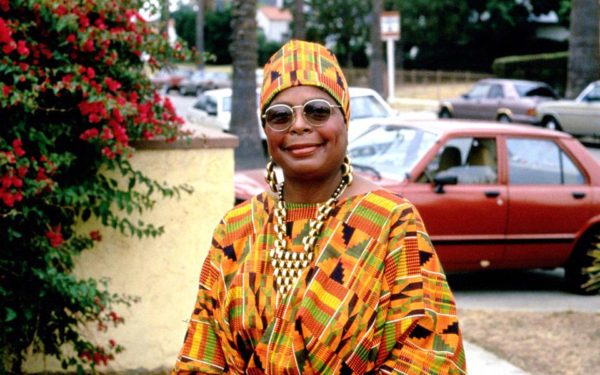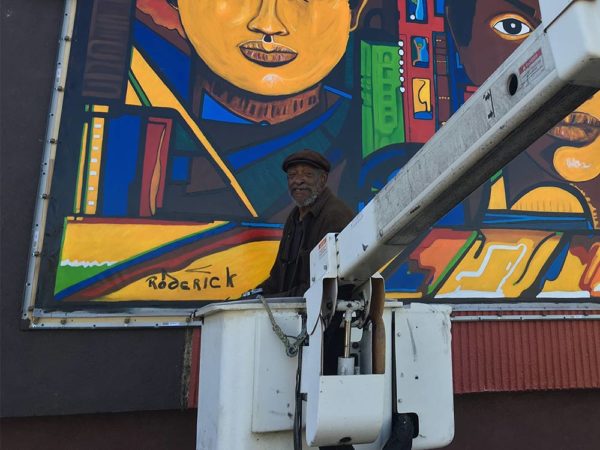14 Black Muralists in LA You Need To Know
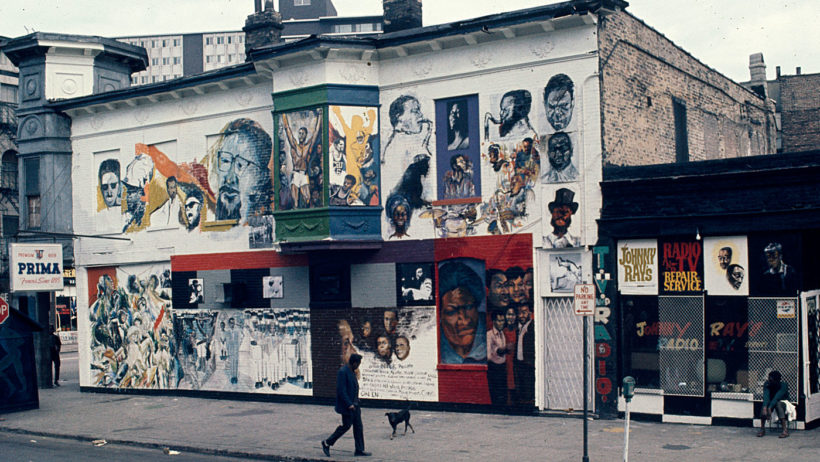
Photo by Robert A. Sengstacke. Chicago, IL.
The community mural movement of the 1960s is defined by a spirit of creative collaboration and political resistance. The social and political landscape of the 1960s was shaped by powerful movements for social justice, including the Civil Rights Movement and the Chicano Movement. The social fervor that drew artists to the streets was the crucible that led to the formation of the Social and Public Art Resource Center (SPARC) in 1976. In “Toward a People’s Art” (1977) authors Eva Cockcroft, James Cockcroft, and John Pitman Weber honor the beginnings of the community mural movement as a transformative creative practice that empowered historically marginalized neighborhoods to represent their histories, experiences, and aspirations in public spaces.
One of the earliest examples of community muralism is The Wall of Respect in Chicago’s South Side, a public artwork that emerged out of a collaborative effort between black artists, including the prolific muralist William “Bill” Walker (1927-2011). The Wall of Respect painted portraits of black leaders and icons onto a building marked for demolition during Chicago’s Urban Renewal initiative in the 1960s. The community in South Side Chicago rallied to protect both the mural and their neighborhood from demolition for several years, and it became a community space for gathering, for painting, for performances, and for honoring identity. The community mural movement extended across the nation in the 1960s, empowering artists and residents in minority neighborhoods to take collaborative action and envision change through art.
Today, in cities across the United States, we are seeing powerful movements for racial justice and demands for an end to the long and painful history of police brutality against black, brown and indigenous communities. As organizers and allies continue to advance a history of black activism, we are taking a moment to honor the artistic legacies of 14 revolutionary black muralists in Los Angeles who have worked for the past 30 years to amplify the voices of black communities in a collective call for justice, dignity, and transformation. All but one of the featured muralists were commissioned through SPARC’s Neighborhood Pride Program. All of the artists continue to have strong ties to the communities they served.
1. Charles Boko Freeman
Charles “Boko” Freeman was a muralist, community activist, and organizer with the Black Panther Party (BPP) in Houston and Los Angeles. A key figure in securing groceries for the BPP’s Free Food Program, he also created numerous banners and artworks during his community organizing. He became a prolific muralist in Los Angeles, having painted several iconic murals throughout the county, including the famous “Spirit of ‘76” still visible atop the Bob Hope Patriotic Hall. He continued to paint dozens of murals throughout Georgia and Nevada, remained active in the BPP throughout his life, and celebrated in their 50th anniversary. Freeman recently passed yet his murals continue to be cherished landmarks in the many communities he touched.
Freeman worked with the Latino community in Los Angeles as he painted “Return to the Light” along the Pasadena Freeway. As he painted the mural, he invited input from the neighborhood and worked with youth apprentices from the community. “Return to the Light” depicts prevalent social ills, including the senseless killing of young people and the issue of widespread homelessness. The shaman in the center of the mural represents a healthy state of wholeness. During the 2015 restoration, he was supported by muralist and collaborator, Noni Olabisi.
Freeman also painted “Education in Our Interest” at Jefferson Middle School in South Los Angeles with assistance from prolific Los Angeles muralist, Noni Olabisi. This mural invokes the greatness of past civilizations from ancestors of both black and brown communities. The mural illustrates similarities in customs and traditions between the African-American community and the Mexican community. “Education is Our Interest” inspires pride and hope in the futures of two cultures that share similar local histories in Los Angeles.

Located at Carlota Park Apartments
227 East Avenue 41, Highland Park, CA 90031 | Mural is in excellent condition
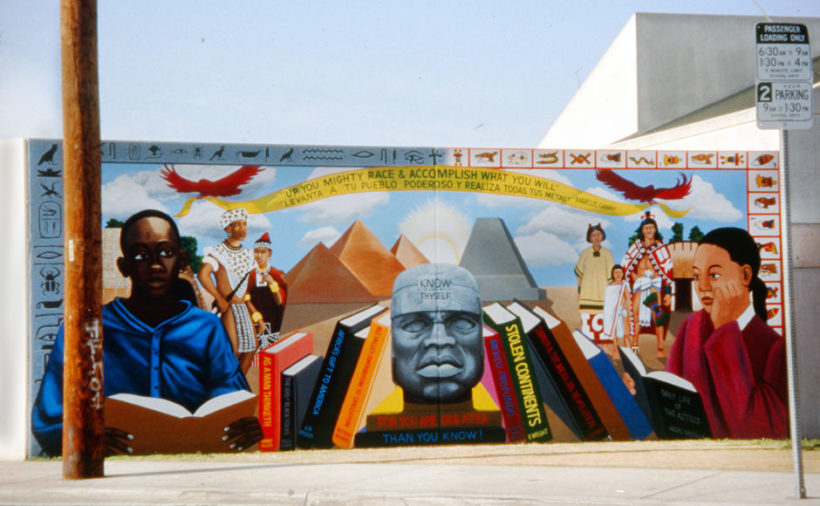
Located at Los Angeles Academy Middle School
644 E 56th St, Los Angeles, CA 90011 | Mural condition unknown
2. Noni Olabisi
Noni Olabisi is recognized for painting several renowned murals in South Los Angeles that depict black history in the United States and uplift the voices of communities most affected by racism and inequity. “To Protect and Serve” illustrates the lesser known history of the Black Panther Party (BPP). After a powerful conversation with Charles “Boko” Freeman about his involvement in the BPP, and the successes and resistance faced by the youth, she was inspired to paint the unwritten history of a community driven by self determination. In her mural, she captured the BPP’s Sickle Cell Anemia Program and Free Breakfast Program that Brother Boko and others had participated in. She continues to produce paintings and public works and resides in South Los Angeles.
“To Protect and Serve” was commissioned through SPARC’s Neighborhood Pride Mural Program in 1992. After the mural received opposition and political backlash from irate elected officials and police, the project lost city funding and was completed with support from private donations collected by SPARC. The mural depicts the Ku Klux Klan, Bobby Seale bound and gagged during the Chicago 7 Trial of the late 1960s, civil rights activists Huey Newton and Angela Davis, and critical social projects implemented by the Black Panther Party, including the Free Breakfast Program. In a 2015 interview with SPARC, Noni Olabisi describes the significance of “To Protect and Serve”: “The mural represents so many brave young people standing up to injustice. To me, it is Courage in the face of injustice.”
Olabisi painted “Freedom Won’t Wait” as part of the SPARC Neighborhood Pride Mural Program in 1992 after the uprising in response to the arrest and beating of Rodney King at the hands of the LAPD. The mural connects a painful history of lynching to a more recent history of police brutality within black communities. The bold message of “Freedom Won’t Wait” is depicted on a protest sign in the mural, emphasizing the importance of demonstration and resistance in the pursuit of systemic change. Olabisi’s “Freedom Won’t Wait” resonates deeply with the powerful movements to end police brutality and systemic racism that we are witnessing today.

Located at 3406 11th Avenue, Los Angeles, CA 90018 | Mural is in excellent condition

Located at 1815 W 54th St, Los Angeles, CA 90062 | Mural is in fair condition and in need of conservation
3. To’Ree’Nee’ Keiser
Muralist To-Ree-Nee Wolf Keiser is now based in Tucson, Arizona, but while in Los Angeles decades ago, she won two Neighborhood Pride commissions. Her multimedia practice as a studio visual artist has continued to grow and fuse her many talents, while her public practice includes mosaic work and large scale mural painting. She draws inspiration from local community members to develop imagery on culture and history in her public art. Her art-as-spiritual knowledge philosophy has continued to channel history from elders across Tuscon.
In The Avenue of Despair, The House of Life, The Place of Hope and Possibilities, Keiser’s mural is an argument for the role that education (represented by books and numbers) encourages a vision that moves from a tragic history into a future filled with hope and possibility. The mural shows how lives in danger and distress can be turned around to a sunny future in the protective embrace of a loving home life.The concept positions education, family, and community as equal partners.
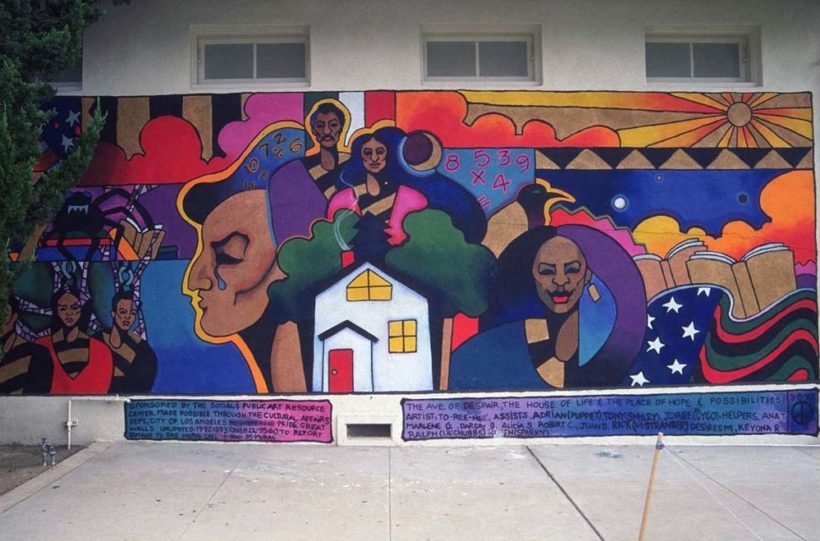
Located at Pacoima Charter School
11016 Norris Ave, Pacoima, CA 91331 | Mural condition unknown
4. Carla Carr
Carla Carr is a fine artist and muralist born and raised in Chicago. She completed her Bachelor of Arts and Master of Arts degrees in Illinois, studied painting in France, and went on to create murals in cities across the United States while also leading a career as a professor of the arts. In 2001, Carr was commissioned by SPARC to paint “The Last Stand” in Leimert Park.
Reading the mural from left to right, it begins with an African jacana figure, which is known as a storyteller in African folklore. The mural is composed of vignettes, some of which depict labor and community resilience, and another of which honors Patrice Lumumba, an African political activist who was imprisoned and killed fighting against injustice in the Congo. The last section of the mural has parchment paper with quotes and sayings from community members as they define what Leimert Park is to each of them. Carr explained: “The community decided that the essence of an African aesthetic was important to capture the vitality of the neighborhood and a sense of cultural identity.”

Located at 4331 Degnan Blvd, Los Angeles, CA 90008 | Mural is in fair condition and in need of conservation
5. Alice Patrick
The earliest African American woman muralist in Los Angeles, Alice Patrick has been a constant producer even into her late years. She continues to create paintings and portraits, publishing them online for all to appreciate. Her recent book, “Alice Patrick: Art and Friends” is a visual autobiography of her long artistic career and the many people she has met along the way.
In “Women Do Get Weary But They Don’t Give Up,” commissioned by SPARC’s Neighborhood Pride Program, Patrick painted portraits of past National Council of Negro Women leaders, Founder Mary Mcleod Bethune and Dorothy Height, sitting down to characterize expressions of pride and courage. Seated on either end are two anonymous women representing the strength of all women–mothers, sisters, aunts, and grandmothers. By providing strength and support, they allowed future Black women to rise to fame. Portrayed behind them are Josephine Baker, Oprah Winfrey, Sarah Vaughan, and Olympic runner Florence Griffith-Joyner. During her summer mural production, she was also assisted by a young emerging artist, Daryl E. Wells.

Located at the National Council for Negro Women
3720 West 54th St. Los Angeles, CA 90043 | Mural is in excellent condition
6. Daryl E. Wells
Daryl Wells is an artist, educator, and community arts organizer who began her public art career as an assistant to iconic Los Angeles muralists, East Los Streetscapers and Alice Patrick. Alongside her work as an artist and muralist, Wells has developed curatorial and cultural engagement projects with an emphasis on social justice in several cities.
Wells won her Neighborhood Pride commission to paint “Not Somewhere Else But Here” in 1993 at the National Council of Jewish Women of Los Angeles, after having been a mural painting assistant for Alice Patrick on “Women Do Get Weary, But They Don’t Give Up.” Wells’ mural was restored to full vibrancy with SPARC’s support in the Fall of 2014. “Not Somewhere Else But Here” embodies themes of community service, social action, and education. The piece depicts influential women from diverse cultural backgrounds “breaking bread” together: Betty Friedan, Barbara Boxer, Hannah Senesh, Dolores Huerta, Lee Krasner, Barbara Jordan, Emma Goldman, Lillian Hellman, Rigoberta Menchu, and Hannah Solomon.

Located at the National Council of Jewish Women
543 N. Fairfax Ave., Los Angeles, CA 90036 | Mural is in excellent condition
7. Ian White
Ian White is a conceptual/performance artist, muralist, and curator based in Los Angeles and New York, and he is the son of renowned artist, Charles White. He developed an interest in political murals during several visits to Nicaragua and has painted public artworks in addition to works on canvas.
White won a Neighborhood Pride commission in 1989 to paint “Genocidal Tendencies” on Jefferson Boulevard. The premise of the mural is that as responsible people, we are obligated to create an environment that is safe and will ensure our children’s future. The mural is bordered by a series of circling Conestoga wagons. The old west anachronism is meant to symbolize the outdated sense of security that people possess, for just as the wagons offered little protection to pioneers, there is no protection for people in the event of a nuclear calamity.

Located at 2526 West Jefferson Park Blvd, Los Angeles, CA 90018 | Mural is in excellent condition
8. Richard Wyatt
Richard Wyatt is a Los Angeles based artist who began studying drawing and painting in Watts and at the Otis Art Institute where he met his mentor, Charles White. Wyatt painted several iconic murals in Los Angeles, including at landmark sites such as Union Station and Capitol Records. He has also led a career as an educator at UC Irvine, Otis, and the Watts Towers Arts Center.
His 1989 SPARC Neighborhood Pride mural commission, “Cecil,” is painted on the Watts Towers Arts Center and pays tribute to Cecil Ferguson, who was known as “the community curator.” The mural shows Ferguson in front of the entrance of LACMA, where he worked for almost 40 years and transitioned from a janitor to a curator. Ferguson was the first African American to attain that position and he encouraged the collection and presentation of more work by black and brown artists in Los Angeles. In 1968, Ferguson co-founded the Black Arts Council to support and help promote young Black artists around Los Angeles. Wyatt’s murals continue to tell the stories of Los Angeles, and his studio work was recently included in a LACMA exhibition at Charles White Elementary School (former site of Otis) curated by Ian White, “Life Model: Charles White and His Students.”

Located at the Watts Towers Arts Center
1727 E. 107th Street, Los Angeles, CA 90002 | Mural is in dire need of conservation
9. Reginald Zachary &
Mary Linn Hughes
Performance and Installation artist Reginald Zachary was originally collaborating with Mary-Linn Hughes on a different project when Hughes received news of winning a Neighborhood Pride mural commission. Naturally, the duo decided to team up and co-create the design for the commission. While neither had previously painted a mural (Hughes being primarily a photographer), they used graphic textile designs and photographs of Minority Aids Project (MAP) staff and locals as models for their maquette. A Tustin resident, Zachary received a master’s degree in studio art from UC Irvine with a focus on performance. Zachary and Hughes met while volunteering at an AIDS organization in the early 90s. To start the project, the duo took up residence at MAP and participated in months of community meetings and photo sessions. Invaluable help came from friends, family members, SPARC painters and MAP volunteers. After all the painting was done, with silver markers in hand, Hughes and Zachary added the names of over 150 men, women and young people lost to the epidemic.
Love is For Everyone was recently restored in 2015 and it continues to be a memorial to the many lives taken by AIDS. The mural incorporates iconography on the challenges faced by the HIV/AIDS community, and resources from MAP. The silhouettes were based on photographs of MAP staff and community members. It is located on the outside of the Minority Aids Project, which continues to offer support to the local community, and more recently, has played a vital role in distributing produce during the COVID-19 crisis. You can find out more in a previous feature of “We’ll Bring the Streets to You.”

Located at Minority AIDS Project
5149 West Jefferson Blvd., Los Angeles, CA | Mural is in excellent condition
10. Ras Ammar Nsoroma
Ras Ammar Nsoroma was born and raised in Milwaukee, Wisconsin and he and his classmates at Milwaukee High School of the Arts completed their first mural at the age of 16. Nsoroma went on to create murals in Milwaukee, Chicago, Los Angeles, and Washington D.C.
In a conversation with Tamara Natalie Madden, Nsoroma says that he wants to create work that has personal meaning and resonance for him. Madden explains that: “Life, spiritually, politics, and culture, are all recurring themes in his work.”
Nsoroma painted “The Resurrection of Watts” in 2001 at the Watts Labor Community Action Committee (WLCAC). The mural depicts the resilience of the community of Watts, and the uplifting of the next generation of black and brown leaders.

Located at the Watts Labor Community Action Center (WLCAC)
10950 S Central Ave, Los Angeles, CA 90059 | Mural is in good condition
11. Elliott Pinkney
Compton-based artist Elliott Pinkney began to create historical murals depicting African American culture as early as 1965 in the city of Compton. Originally from Brunswick, Georgia, he moved to California to pursue a BA in Art from Woodbury University. He dedicated his life to creating murals on African-American freedom and pride, and often coalesced Black and Brown leaders in his subject matter. Pinkney passed on December 22nd, 2019, leaving behind a legacy of artistic contributions to the Los Angeles community mural movement.
Visions and Motion, commissioned by SPARC in 1992, with its vibrant colors, was intended to brighten the lives of those who view it, especially the youth. The role models depicted are Muhammed Ali, Malcolm X, Cesar Chavez, Florence Griffith Joyner, Magic Johnson, Sammy Lee, and Jim Thorpe. Sadly the mural was overpainted during the Metro Crenshaw expansion after years of disrepair. It is no longer visible, but with funding for conservation it could be recovered.

Located at The Community Youth Sports and Arts Foundation
Once located at 4828 Crenshaw Blvd. Los Angeles, CA 90043, | Mural was overpainted and is no longer visible
12. Roderick Sykes
A co-founder of St. Elmo Village, Roderick Sykes has been a keystone of Los Angeles’ artistic community. He is a prolific painter and talented community organizer. In his younger years, he produced dozens of public art commissions throughout Los Angeles, and even supported SPARC projects like the Great Wall of Los Angeles as a supporting artist. Sykes continues to be a pillar of St. Elmo Village along with his wife and visual artist Jacqueline Alexander Sykes, who now spearheads the nonprofit.
Sykes’ Neighborhood Pride commission, “Literacy,” was once located at the Los Angeles Unified School District maintenance building on Pico Boulevard. The original mural was painted with help from three local youth who grew up taking art classes at St. Elmo Village. The mural celebrates the diverse ethnic population of Los Angeles with three faces of an African American, Asian and Latino. It serves as a powerful reminder of the importance of literacy, creative expression and love of community. Assisted by Jacqueline Sykes during the 2015 recreation, the new “Literacy” mural now resides on the second floor of the St Elmo Village “High Rise.”

Located at 4846 St. Elmo Drive, Los Angeles, CA 90019 | Mural is in excellent condition
13. Jacqueline Alexander Sykes
Jacqueline Alexander Sykes is a visual artist who today oversees St. Elmo Village, an arts nonprofit and community space founded in 1969 by artists Roderick Sykes and Rozzell Sykes. Jacqueline and Roderick have been married for 40 years, and have collaborated on dozens of public artworks and programs throughout Los Angeles. In a recent interview with Artillery Magazine, Sykes explains St. Elmo Village is “a lot of circles that intertwine. We’re not just in the ‘art organization’ box.” In addition to her leadership at St. Elmo Village, Sykes continues to paint and create amongst a new generation of St Elmo Village artists.
Her mural, “Common Roots, Common Symbols,” painted in 2008 is opposite the landmark Helms Bakery, and can be seen driving eastbound on Venice Boulevard. The mural is a symbolic confluence of three cultural tapestries that intersect at the base to feed an oasis of variant flora. The landscape is formed by an intersection of colorful geometric triangles that resemble the horizon of surrounding mountains. Together, the geometries allude to the patterns found in fabrics and nature, that bound us to a common origin point–the nascence of creativity.

Located at 8773 Venice Blvd, Los Angeles, CA 90034. | Mural is in fair condition and in need of conservation
14. The Shaw Park Muralists
In 1991, the Shaw Park Muralists formed to create the “Black Seeds” mural. Originally an idea that was on his mind for years, local resident and community activist Gus Harris Jr. commissioned artist Moses X. Ball to create a painting based on his vision of an African American tree of life. Harris Jr. recalled how African American achievements were excluded from history books in school. The Shaw Park Muralists saw the blank wall adjacent to the Leslie Shaw park as an opportunity to change that.
Ball’s painting would later become the maquette for a SPARC Neighborhood Pride commission. The collaborative group that formed around Ball included local artists Eddie Orr, David Mosley, William T. Stubbs, Norman Maxwell, and Michael McKenzie. Together, the group created an interwoven tree with branches containing notable historic Black activists and leaders.
Each branch collectively forms a monument to the important contributions made by black individuals who rose to prominence for their stance against slavery, their participation in the civil rights movement, and social contributions. The mural features antislavery leaders Harriet Tubman and Frederick Douglass, Mary McLeod Bethune, Malcolm X, Paul Robeson, Martin Luther King Jr. and many others. The inspiration behind the mural can still be found on display at the local Oaks Jr. Market corner store at 5th and Jefferson Blvd.

Located at 2301 West Jefferson Blvd. (at 3rd Ave.) Jefferson Park, Los Angeles, CA 90018 | Mural is in good condition
###
SPARC’s Mural Rescue Program is responsible for the conservation of many murals throughout Los Angeles. It is sponsored from private donations and grants. For more information on our conservation services and products visit MuralShield.com. Mural conditions are based on last known assessments and community information. If you know of a mural featured in this article with a condition different than is listed, please email a photo and message to info@SPARCinLA.org. Follow us on Instagram and check out We’ll Bring the Streets to You for more content on Los Angeles murals.





